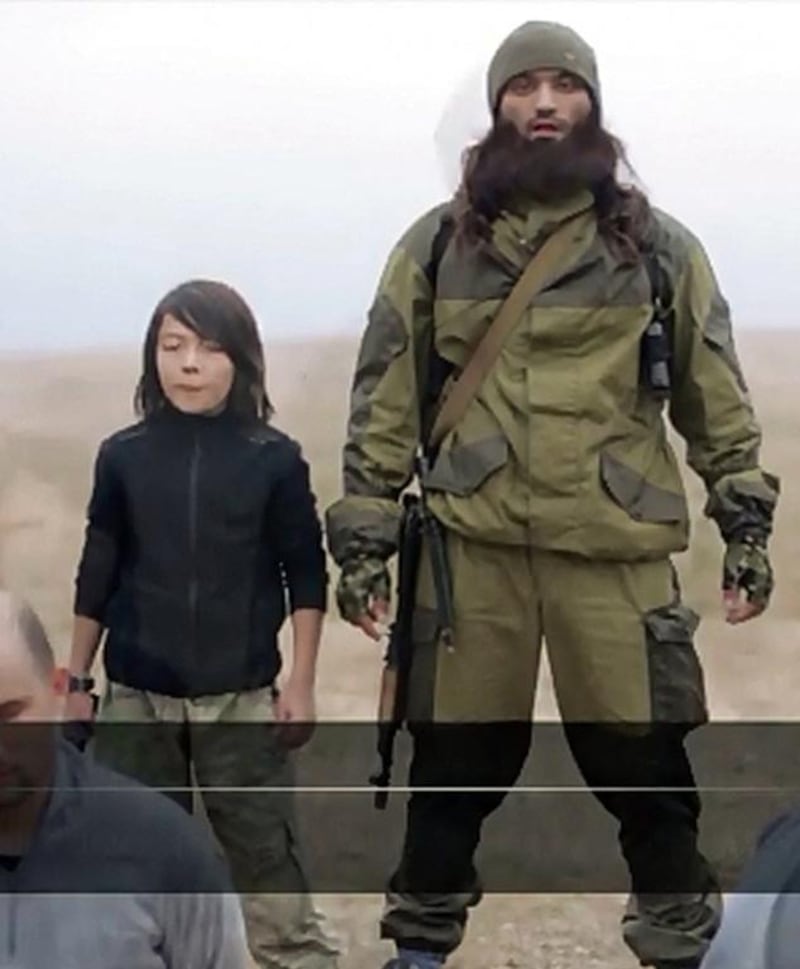LONDON // ISIL is systematically training children on an “unprecedented scale” as frontline soldiers, suicide bombers, executioners and spies, according to research to be presented to the UK parliament on Wednesday.
The Quilliam Foundation, a British counterextremism think tank, detects a strategy to use young children and teenagers as props of the self-styled caliphate’s governing apparatus and as a propaganda tool.
Quilliam’s researchers have translated and analysed a large body of promotional material featuring children and disseminated by ISIL since August last year.
The strategy they detect – “unprecedented both in scale and in breadth” – attempts to breed a new generation of fighters better and more lethal than the current volunteers, concluded the researchers who also consulted sources in ISIL-controlled territories in Iraq and Syria.
"Rather than being converted into radical ideologies, children have been indoctrinated into extreme values from birth or at a young age," said researchers in a report entitled Children of Islamic State.
“While in the past children were used [in conflicts] in spite of their youth, they are increasingly being used [by ISIL] because of their youth,” they added.
“This is in part because children can be easily trained to handle small arms, weapons that can be carried and used by one or two people, including handguns, assault rifles, machine guns, grenade launchers, anti-tank or anti-aircraft guns and light mortars.”
Noman Benotman, co-author of the report and Quilliam’s president, cites a senior intelligence officer’s estimate that 31,000 pregnant women of all nationalities currently live within the areas of Syria and Iraq run by ISIL.
While some children in ISIL-controlled areas of Iraq and Syria were born there, others were taken their by their parents. In particular there have been many well-documented cases of adults from various countries taking their children to live in and around Raqqa, ISIL’s Syrian stronghold.
There are no firm statistics breaking down the countries of origin of children who have been taken to ISIL-controlled areas, or of foreign women who have given birth there, but according to Quilliam’s figures, as many as 50 children from the UK are living under the extremists’ control.
The think tank’s researchers were most concerned by evidence of ISIL preparing for future military needs “by indoctrinating young children in its schools, and normalising them to violence through witnessing public executions, watching Islamic State videos in media centres and giving children toy weapons”.
In videos circulated on social media since last August, the report states, ISIL has shown 12 children acting as executioners, in one case participating in a public execution.
“The ... focus on child executioners may be an attempt by Islamic State to project an image of strength and endurance in response to heavy air strikes,” said the report.
“By using children as soldiers and executioners, Islamic State attempted to convey the message to foreign audiences that air strikes are not effective against the future generation of fighters, because, ‘although you prepare your armies, we too are preparing ours’.”
The report cites examples of the extremists encouraging children to participate in public brutality, such as holding up or playing football with decapitated heads, and allowing them to witness stonings and crucifixions.
“Children not only get desensitised to violence, but they also deem these practices as normal, and eventually defend them,” it said.
“Children have been seen accompanying prisoners to their death and, in one example, distributing knives to adults before a mass beheading.”
Meanwhile, ISIL treats the education system as central to shaping the hearts and minds of the next generation, from early indoctrination in school to training camps for those aged 10-15.
“Boys learn a rigid Islamic State curriculum, where drawing, philosophy and social studies, the ‘methodology of atheism’, have been removed,” the report said. “Instead, children churn out memorised verses of the Quran and attend ‘Jihadi Training’, which includes shooting, weaponry and martial arts.”
“Girls, also known as the ‘pearls of the caliphate’, are veiled, hidden, confined to the home, and taught to look after husbands,” it added.
The report makes a series of recommendations, urging the creation of a commission, funded by EU member states and administered by NGOs, to “protect future generations from radical violence” and oversee monitoring and reintegration of children within the European Union.
The think tank believes the report is the first of its kind to provide an insight on how children “growing up on jihad in Islamic State” might be rehabilitated if they eventually escape or otherwise return to their countries of origin.
“Looking to the future, it is inevitable that these children will suffer from severe physical and mental trauma, as well as systematic extremist indoctrination,” Quilliam said.
Mr Benotman himself once “adopted radical Islamism”, according to his biography on the think tank’s website.
Born in Libya, he helped created the Libyan Islamic Fighting Group that plotted the failed violent overthrow of former leader Muammar Qaddafi and later, in Sudan, forged close links with Osama bin Laden, Ayman Al Zawahiri and other Al Qaeda figures. He gradually distanced himself from extremism after moving to London in 1995.
foreign.desk@thenational.ae






